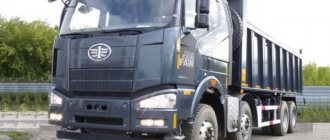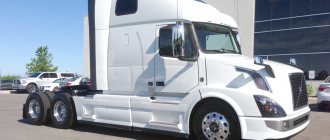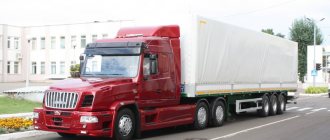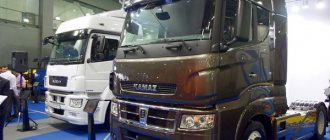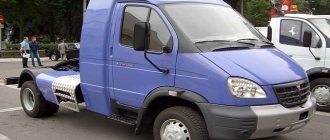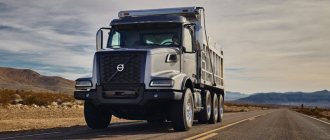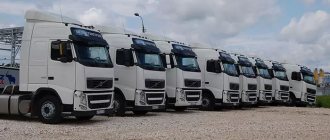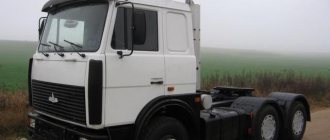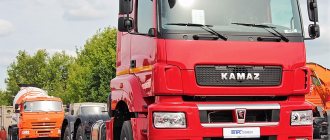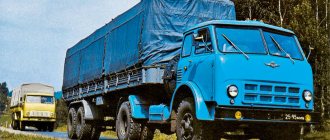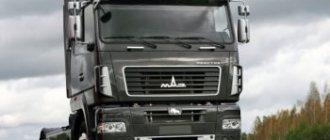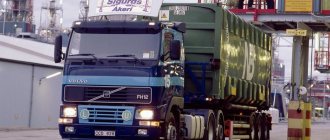- Story
- Characteristics
- Reviews
- Cabin
- Video
The DAF CF is a full-fledged long-haul tractor by design, but it has become most popular as construction equipment. Largely due to the low price and optimal power.
The extensive automobile series dates back to 1998. This year, the first machine, then called DAF 85CF, came off the assembly line. The car was produced under this name until 2002. The production of modern DAF CF trucks continues to this day.
Spare parts for DAF CF directly from manufacturers
Historical excursion and today's DAF CF
Two years before the start of serial production, the Dutch company DAF was sold. The owners were the Americans PACCAR - the third largest producer of heavy trucks in the world. The brand, despite the deal, remained independent and preserved in its original form. But under the hood there are more and more details typical of American “trucks”.
DAF is one of the few companies whose cars are assembled, as they say, around the world. Thus, some models are assembled in the UK by Leyland Truck. On the chassis and cabs you can find markings of Belgian factories. At the same time, the company has perhaps the most developed dealer network in the world, which includes Europe, Africa, New Zealand, the Middle East and others.
Representatives of DAF and Russia were not spared. Since 2011, the Dutch company has opened a subsidiary in our country. DAF strives to cover as wide an area of influence as possible in the global automotive market. But the main thing that stands out for itself is quality. This is reflected in the DAF motto: “Driven to quality”, which can be translated as “Driven by quality”.
An interesting feature of CF trucks is the model with the steering wheel mounted on the right. Such models, as well as rigid frame vehicles, are produced only in the UK, at the Leyland Trucks plant. This is due to some features of roads in England. For example, with left-hand traffic on roads and highways.
DAF CF: technical characteristics and equipment of tractors
The CF series has received many innovations. It was on this model that the company abandoned drum brakes in favor of ventilated disc brakes, albeit very reluctantly. The new braking system is equipped with EBS - electronic control, without which a modern heavy-duty vehicle is unthinkable. Here, additional fixation of the discs was used using serrated protrusions.
This solution was borrowed from ]Volvo[/anchor]: Volvo FH cars are equipped with additionally reinforced wheels. This system avoids distortions and holds the discs more rigidly. DAF Trucks traditionally produces its axles and frame in-house. At the same time, the company tried to provide as much choice as possible to car buyers.
More on the topic: Universal tractor Kenworth T800 – the pride of the American automobile industry
Hypoid axles, typical for long-haul tractors, interwheel and center differential locks, spaced final drives on drive axles and much more. Gear ratios are selected based on wheelbases and tonnage. The frame is made of high-strength steel and has a flat surface for easy installation of additional equipment. This is also related to the scope of application of the truck.
Operating the DAF CF: economical performance and comfort
Unlike the adjacent model range - DAF LF, interesting for its compact size and multifunctionality, the CF series has become larger and more highly specialized. Not as powerful and large as the representative of the “business class” DAF XF, this vehicle received optimal characteristics and a margin of safety for relatively off-road driving, and therefore gained popularity as a dump truck and concrete mixer, as well as a rally truck.
The design and parameters of the DAF CF 85 allow the machine to be used in various off-road racing, where DAF is no longer a newcomer.
Paccar did have an influence on the configuration of cars. All new cars are equipped with engines of this particular American brand. For this series, three types of motors are offered, meeting standards from Euro 3 to Euro 6. Two medium-power motors are provided as standard.
The 6.7-liter Paccar GR engine is designed to produce between 200 and 300 hp. at 1100 Nm maximum torque. The DAF CF 65 received this compact engine. The DAF CF 75 is equipped with a PACCAR PR unit of 9.2 liters with 1450 Nm. Compliance with high environmental standards is possible thanks to the exhaust recycling and recycling system.
The DAF CF 85 received the maximum version of the PACCAR MX engine, which has the following operating parameters:
- Engine volume - 12.9 liters;
- Four power options: 510, 460, 410 and 360 hp;
- High torque from 1775 to 2500 Nm;
- Engine service interval - 90,000 km (for GR and PR models - 75,000 km);
- When using synthetic oils and special centrifugal filters, the interval can be increased to 150 thousand kilometers;
- The engine has an export version that complies with the Euro 3 standard.
Comfort inside the DAF CF and style outside
The 2013 DAF CF truck has a cozy and comfortable interior: calm colors, fabric upholstery and non-straining plastic. For the driver there is a lot of free space and excellent visibility.
The dimensions of the car are more modest than those of the XF series: the cabin is slightly narrower. At the same time, the CF has a rather high (440 mm) motor shaft, which is absent on the flagship version. The chassis and attachments of the series are identical. There is a slight difference in the width of the sleeping shelves and the internal space. The cabins are standardly produced in three versions: day, standard mainline and Space version - increased comfort, more than two meters high.
More on the topic: Chinese trucks Foton BJ1039
Drivers will appreciate the car's conveniently adjustable tilt steering wheel and, of course, the design of the seats. Anatomical chairs are fully adjustable and equipped with pneumatics. There are headrests and seat belt adjustment. True, all this concerns the driver’s seat: the passenger seat has practically no adjustments.
The cabin is made of metal, but some parts are plastic. This does not apply to the bumper, which, in addition, is also monolithic. For a machine on a construction site, this is an omission. The design of DAF is laconic and intelligent rigor, but at the same time bright combinations of colors: bright sunny yellow, red, orange, blue.
You can buy a DAF CF starting from 82 thousand euros. For so little money you can buy medium power in combination with a daytime, low cab. Optionally, you can add a spoiler to the DAF CF, a sun visor, and an auxiliary fuel heater. It all depends on the purpose of the car.
DAF has proven itself to be a reliable carrier, which is why the new CFs are popular in Europe. In Russia, the brand is beginning to gain momentum. In general, drivers have a positive attitude towards the DAF brand, recalling the successful DAF XF95 model, which performed well. Time will tell how things will go with the new episodes.
Test drive DAF CF85 (DAF SF85)
Well, it’s okay, if you have the strength to read everything that is written below today, tomorrow you will be able to point your finger at a passing DAF and tell your girlfriend in the next seat: “This is a DAF driving. Think about it, it has disc brakes all around.” And even if this doesn’t mean anything to her, it will be imprinted in her subconscious that someone cooler than Deadpool and Jason Statham is sitting next to her. In any case, they didn’t know much about trucks. So, let's go.
Trailer with motor
Let's be honest: the average car enthusiast knows a little less about DAF than a wheelie driver or second-series driver knows about conscience. I personally saw a person who called this beautiful car “Chinese”. It just so happens that, of all the tractors on the road, we easily recognize only Kamaz (and only the old one) and, perhaps, Volvo because of the characteristic diagonal line on the lining. Meanwhile, DAF is also worthy of respect, and its history is no less interesting than that of many other famous manufacturers.
The Dutch Army's Chevrolet Model QD artillery tractors were fitted with the Trado rear four-wheel drive bogie on the DAF (1934)
The founders of the company were two brothers with not the most simple names: Hubert Joseph and Billem Anthony Vincent van Doorne. In 1928, they opened their own workshop, Commanditaire Vennootschap Hub van Doorne's Machinefabriek, where they produced various metal structures, such as stairs, cabinets, stoves and window bars. By that time, one of the brothers, Hubert, already had experience repairing simple but capricious cars of that period. And the workshop began to slowly change its profile. Its product range began to include carriages for horse-drawn carriages, then trailers for tractors and, finally, trailers and semi-trailers for cars.
In 1934, the workshop was already called the trailer factory of the van Doorne brothers. In their native language it sounded like Van Doorne's Aanhangwagenfabriek. To prevent customers from accidentally breaking their tongue, the name was shortened to the familiar abbreviation DAF. Its final transition to the production of car trailers dates back to the same period in the company’s history. There were still 15 years left before the first truck.
Building the engine turned out to be more difficult than building the trailer. And the trailers didn’t want to drive without it. And yet, a solution was found: the brothers bought cars or light trucks with a 4x2 wheel arrangement, threw out the rear axle and installed a two-axle trolley instead with a drive on both axles. The result was trucks of varying degrees of comicality, but with the same 6x4 formula. The carts were called Trado, where “do” is the first letters of van Doorne’s surname, and “Tra” is the beginning of the surname of the engineer who developed the design, Von der Trappen. Be that as it may, we have already achieved something close to our car.
Using Trado trolleys it was possible to easily convert a 4x2 vehicle into a 6x4 vehicle
Although we know this company as a manufacturer of trucks, the first vehicle was not a tractor or a dump truck, but an amphibian, which was planned to be produced for the needs of the army. MC139 (that was the name of this car) had a centrally located engine, a 4x4 wheel arrangement, and the car was symmetrical and could drive equally well forward and backward. However, this Push-Pull did not gain much popularity, despite its very original design. Subsequently, the company returned to the idea of a passenger car and by 1975 even managed to produce a dozen models. But recognition came only on the “cargo” front, so we won’t talk more about DAF passenger cars.
In 1940, the development of the first own truck began. The designers worked for eight years, and the result of their work was two vehicles, DT5 and DT10, with a carrying capacity of 5 and 10 tons, respectively.
DAF DT5
Three years later, DAF already offered a fairly wide range of trucks, which were equipped with American Hercules or English Perkins engines, and you could choose either a gasoline unit or a diesel engine. And if in 1949 only 150 cars were produced, then in 1954 more than three thousand were built. By the end of the 50s, DAF was able to start producing its own engines.
In 1957, the company still sinned by releasing a series of hooded trucks A12 and A15. Before 1970, the bonneted A13, A16 and A18 were released. The company did not allow itself such arbitrariness anymore, but in 1961 it built the first tractor with a sleeper - AS2000DO.
DAF AS2000DO
Over time, DAF began to slowly divide its priorities. Passenger cars were the first to be separated. In 1975, this division was sold to Volvo, which resulted in the release of small models of the 400 series, and then the first generation S40. Subsequently, Volvo abandoned the Dutch assembly, and now Smart is assembled there. The bus division of DAF Buses also does not exist: in 1990 it went to United Bus, which lasted only three years.
Actually, the main “cargo” division also lost its independence. In 1996, DAF Trucks was purchased by the American company PACCAR, which owns such monsters as Kenworth and Peterbilt. Even before this event, DAF released three series of trucks, the most popular in Russia: XF (heavy), CF (medium) and LF (light).
Our car today belongs to the middle CF series, which was released back in 1982 and then underwent major modernization in 1998. The test specimen was released in 2002, 20 years after the start of production. Don't be surprised, this is normal for trucks.
It was around this time that these trucks were just starting to be tested in Russia: DAFs did not arouse interest in our country for a long time. But in vain. But already in 2011, a subsidiary was opened in Moscow, which suggests that the Dutch truck was still recognized in our country, and quite quickly. Well, better late than never.
It's time to walk around the truck.
What to look for?
Frankly, it’s hard to imagine a more boring tractor. Of course, the truck is not a Ferrari, the look of it shouldn’t make the hair on your legs move, but still. Probably, the advantage of tractors is not in their exterior; they should command respect for their colossal mileage between services, reliability and ease of use. But the soul demands it! Okay, let's leave the emotional worries alone and try to find at least something interesting.
First, let's decide what kind of cabin we have here. It’s called CF Day Cab, and anyone who didn’t faint when asked “what’s in duty today” during their school years will guess that it’s just a day cab, that is, without sleeping places. This is the simplest solution. With a height of 1.6 meters, it has a length of only 1.77. The cabin with one “sleeper” (CF Sleeper Cab) is slightly longer - 2.2 meters, and the most spacious cabin (CF Space Cab) has the same length, but much higher - 2.23 meters. The width of all cabins is the same and is 2.26 meters.
A design feature is the side windows of the cabin. They consist of two parts, and only one is omitted. Why this is so is a mystery; maybe there is simply not enough space in the door for all the glass, the area of which is quite large.
Our tractor has a 4x2 wheel arrangement. While the CF series isn't as advanced as the heavier XF, the CF85 still has a mature chassis package. There are cars with the formula 4x2, 6x2 and even 8x4. Truck tractors are produced in 4x2, 6x2 and 6x4 modifications. Our version is the most modest, 4x2, with a total weight of 18 tons, in a road train - 40. The heaviest modification is much more serious: the total weight is 26 tons, and in a road train it can reach up to 58 tons. Sounds impressive! And what we have inside?
Modesty above all
The interior of the tractor, just like the exterior, will not delight an esthete. Not wanting to deprive the driver of comfort, but in an attempt to make the CF series as accessible as possible, the developers have made every effort to ruthlessly remove all the “superfluous”. It turned out more convenient than cute. From the materials of the dashboard one can hear: “I am a workplace, you will relax in the bar.”
There is only a rug on the top of the panel, which seems to hint that you can drink coffee in the cabin, and it’s not even forbidden to spill it. Against the background of the spartan decoration, the sunroof and the dashboard look fantastically chic. The latter is simply wonderful: informative, convenient, even a little too bold for the general interior, like the Christmas tree in the district prosecutor's office.
The main part of the panel is occupied by the on-board computer, which has a wide range of functions, even something so necessary for a truck driver, such as an alarm clock. At the same time, the digital windows of the odometer and thermometer (with a clock) are placed separately: the first is on the speedometer scale, the second is on the tachometer. By the way, the mileage of our car is already close to a million – 910 thousand kilometers.
The layout of the controls is standard; you won’t find anything unfamiliar here, nor can you “lose” any lever or button. But budget is evident from every element, and especially from plastic. In an attempt to make at least something beautiful, the designers used two colors in the design, both of which were somehow vague and strangely combined with each other.
Let's say that the combination of panel colors is a matter of taste, so we won't complain too much about it. The main thing is that this tractor is quite pleasant to drive. And even though the air conditioning was installed here only as an option, the heater works properly, the interior does not knock or squeak, the windows open and close, and the door locks work like new. That is, everything that usually gradually becomes destroyed after a long mileage, here is original and requires almost no periodic repairs.
Well, one more important factor: this is, perhaps, the only cabin where you can easily climb in and then get out. To an untrained person, the cabin of almost any cabover truck will not seem very convenient for these operations, but on the CF, the steps strangely coincided with the door opening, making the landing process unexpectedly convenient. And now the main question: how does it drive?
Pull-pull
After the purchase of DAF by American Pakkar, most DAF CF85s were expected to be equipped with PACCAR GR and PACCAR PR engines. The more powerful PACCAR MX is slightly less common. In addition to these power units, Cummins engines were widely used, but in the later CF85s it was Paccaras that predominated. Our car with the engine was lucky: there is a PACCAR MX. And although the maximum power of this engine reaches 510 hp. s., ours is a little weaker - 380. And yet this is more than the smaller PACCAR GR and PR, whose power averages 200-350 hp. With. The volume of our engine is 12.9 liters, it is a turbodiesel unit, the maximum torque of which exceeds 2,000 Nm. It's quite enough for a small truck. Let's start the engine.
Yes, the running engine doesn’t whisper, but actually says out loud: “Guys, the car is 14 years old. I don’t promise you the silence of a Mercedes, don’t even expect it.” Well, no need, you might think. The main thing is that it works smoothly and does not require frequent repairs. And it just pulls great! You can only touch the gas pedal a little. True, we drove a tractor with an empty scow, but the reserve of power is felt. The maximum speed is electronically limited to 85 km/h, and this is also enough: the two-axle tractor is quite maneuverable, but in terms of stability on the highway it lags slightly behind cars with a 6x4 or 6x2 formula.
The gearbox on our DAF is far from the newest: a 16-speed ZF manual (eight gears with a divider). Newer cars have ZF 16S181 or ZF 16S221 gearboxes with push-button control or ZF AS-Tronic automatic transmissions. But we have a simple, but pleasant-to-use “mechanics” - here the lever travel is not too long, and the shift clarity is quite decent. The only thing that took a little getting used to was the location of the lever, which was shifted back and therefore located at an angle to the floor surface.
Special mention should be made of the brakes. DAF was one of the first to use ventilated disc brakes on tractors, abandoning drums. This happened, however, a little later than the release of our car, so we have drum brakes.
Of course, good traction depends not only on the engine, but also on the transmission. The mistrustful DAF traditionally makes its bridges itself. Gear ratios depend on the modification of the car, but there are almost always inter-axle and inter-wheel locks.
And yet a million
For the vast majority of modern passenger cars, a mileage of a million kilometers is unattainable, just like being three hundred years old is unattainable for a person. Of course, tractors always have a longer lifespan - that’s what they do, especially on the highway. But the fact that this DAF has already run almost a million cannot but go unnoticed. Despite a decent number of other cars in the company's fleet, the DAF can still be considered one of the most popular and even favorite cars.
Yes, there are newer and more interesting cars there. This may be true, but what DAF doesn't care about is practicality. He may be drab and boring, but he gets the job done and doesn’t ask to retire. And who will let him go! Such a worker - unpretentious and hardy - is always valuable.
We thank the logistics department for providing the vehicle.
DAF CF 85: owner reviews
Valentin, Ryazan, car DAF CF 85.460, manufactured in 2008
I purchased a car for cargo transportation between neighboring cities. I bought it used, but in good condition. I’ve known Dafami for a long time, I’ve driven XF and other series. Decent, compact car. For those who keep a large fleet of different DAF series, it is convenient - many parts are identical for the cars, for example, spare parts for the brake system, hubs, and “hitch.”
All cars are of the same standard, even the cabins are almost the same. Only the powers and tasks are different. The car is not capricious, but there are nuances and a number of shortcomings. For example, cars are afraid of overloads, this is due to the design of the rear springs, which does not provide for such an operating mode. For northern regions, the cabin needs to be insulated; a European car does not have powerful heating. We often drive through mud and you know what the weather is like.
So there were problems with the brake system, which did not work well due to contamination. I heard that there are differential locking failures, but this is rare. Cars are susceptible to fuel, although this is not news to anyone. Fuel consumption when fully loaded is about 39 liters per 100 km. A bit much. But the news was that if you install non-original parts and spare parts, this is fraught with breakdowns and the risk of unstable operation. Therefore, as soon as possible, we are waiting for parts to order. Filters need to be changed on time, especially the moisture-oil separator. Pros:
- The suspension doesn't rattle;
- Interchangeability of parts with other DAF CF vehicles;
- Good anti-corrosion coating (cabin guarantee up to 10 years);
- Cars are imported into Russia without Ad Blue, there is no need to turn off the urea;
- A small number of electronics - the DAF CF only has what is necessary, so in cold weather there is less risk of failures.
At what mileage should DAF fuel equipment be repaired?
So that you understand me better, I will give several examples from work experience when I had to repair the fuel equipment of cars with mileage of 7500 km, 20-30 thousand km and 75-120 thousand. Using these three runs as an example, I would like to share my experience, and then it’s up to you to decide whether to take DAF or not. The mileage is 7500 km - I’ll make a reservation right away, I didn’t come across any younger cars, it was for 7500 km that the warranty was considered, I won’t go into details of how the process happened, but the result was this - there was dirt in the nozzles, in all six nozzles, after washing in The nozzles in the ultrasonic bath began to work, but not everyone invested in the tolerance parameters, so it was decided to replace the nozzles with new ones. The owner of the car carried out the fuel analysis and cleaning of the fuel system himself, at a dealer service station, so I don’t know all the details, I only know that he paid for the repairs himself and the case was not covered by the warranty, since dirt was found in the fuel. Only the repair of smart injectors with mounting rings and a washer cost about 60,000 rubles, without removal/installation 20-30 thousand kilometers or more - mostly with such mileage come cars that are in operation with large carriers, where drivers often change. The cause of the breakdown is always the same - wear of the valve and nozzle due to foreign impurities and/or dirt in the fuel. Accordingly, 80% of such cars have cheap fuel filters. No matter how much they said or advised, install the original DAF filter and find a gas station with high-quality fuel, it’s all useless; if the owner fulfills the conditions, the driver will rent the fuel at the “left” gas station. Repairs in such cases cost approximately 230-270 thousand rubles. Sometimes there is a smaller amount, since it is possible to save some pump sections and smart injectors after ultrasonic cleaning. 75-120 thousand mileage - with this mileage private owners come to service stations, these are those car owners who themselves are the owners, and sit behind the wheel. According to conversations, you have to trust this group of people, since the stories are the same - I bought a car with a mileage of about 10,000 km abroad, I drive it myself, I don’t trust anyone and I take care of the car, I refuel only at proven gas stations. They also have almost the same problem - the fuel equipment goes beyond normal parameters due to natural wear and tear. Repairs amount to 230-270 thousand rubles. In this case, it is not possible to carry out partial repairs; all pump sections and smart injectors have to be overhauled. Here are three examples, and these are not isolated cases, but statistics, from which only one conclusion can be drawn: If you look after your car and fill up with Russian fuel, but at proven gas stations, then you can forget about the fuel system for 100,000 km on the DAF (only change the fuel filters and change the low-pressure pump every 40-45 thousand), and if you use all sorts of nonsense, then you will have to often visit the fuel workshop.
